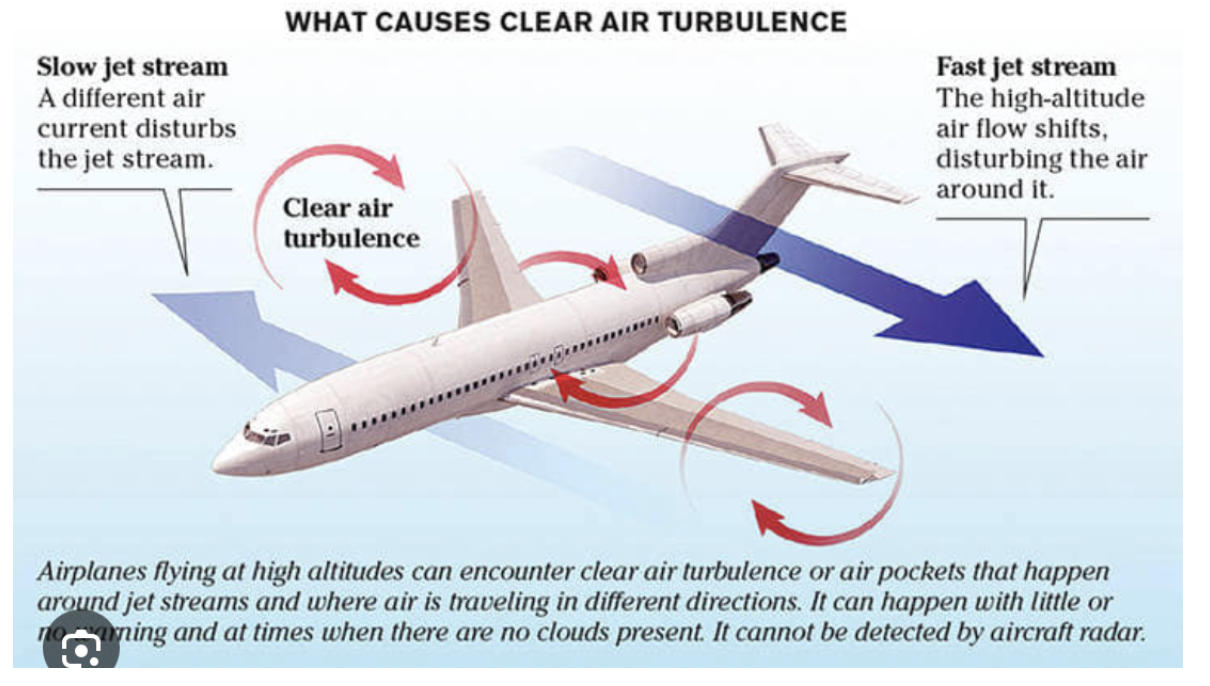
(BUCKLE UP WHEN FLYING - CLIMATE CHANGE MAY BE INCREASING CLEAR-AIR TURBULENCE)
May 29, 2024
Hello everyone,
Scientists at Reading University in the UK have studied clear-air turbulence.
Their research shows that severe turbulence has increased by 55% between 1979 and 2020 on a typically busy North Atlantic route.
Scientists have found that changes in wind speed at high altitudes due to warmer air from carbon emissions have played a role.
Prof. Paul Williams, an atmospheric scientist at the University of Reading has co-authored a decade-long study in this area. He argues that the focus should be on investing in improved turbulence forecasting and detection systems to prevent the rougher air from translating into bumpier flights in the coming decades.
Flight routes in the USA and North Atlantic have seen the largest increases in turbulence. Europe, the Middle East, and the South Atlantic also have seen significant increases in turbulence.
Prof Williams explained that increased turbulence was due to greater wind shear – or differences in wind speed – in the jet stream, a strong wind system blowing from west to east, about five to seven miles above the Earth’s surface. Williams further shows that it exists largely due to the difference in temperature between the world’s equator and poles.
While satellites can’t see the turbulence, they can see the structure and the shape of the jet stream, allowing it to be analysed.
Radar can pick up turbulence from storms, but clear-air turbulence is almost invisible and hard to detect.
We all know that turbulent flights are uncomfortable, but they can also cause injuries for those on the flight. Severe turbulence is very rare, but clear-air turbulence can come out of the blue when passengers are not belted in.
It is sensible to keep your seat belt fastened all the time, unless you are moving around.
The financial costs for airlines can be huge. The aviation industry loses between $150 and $500 million in the US alone annually because of turbulence, including wear and tear on aircraft. There is also an environmental cost, as pilots burn up fuel avoiding the turbulence when they can.
A case in point is the Singapore Airlines flight (SQ321) from London to Singapore on May 21. About 10 hours into the flight when the staff were serving breakfast, the airline hit severe clear air turbulence passing over the Irrawaddy Basin (Myanmar). The crew requested an emergency landing at Bangkok airport as one of the passengers had died. At least 50 people were injured including two crew members and a toddler. All were admitted to a hospital in Bangkok; some had serious injuries. More than 20 were admitted to ICU with spinal injuries. (Many people were obviously not wearing their seatbelts).
On Sunday, May 26 a Qatar Airways flight from Doha to Dublin experienced clear air turbulence but managed to land safely in Ireland. 12 people were injured and eight were taken to hospital.
In August 2023 a Delta flight hit severe turbulence about 40 miles outside of Atlanta catapulting passengers out of their seats. Another incident involving an Allegiant Air flight last July that was flying from North Carolina to Florida. One passenger described the experience like being in “The Matrix.”
NASA is working on a way to detect clear-air turbulence.
The technology, under development at NASA’s Langley Research Centre and involving government, university and private sector experts, anticipates using ground-mounted infrasonic microphones that can pick up ultralow frequencies produced by turbulence -possibly as far as 300 miles away.
Such microphones could provide an early warning for what’s known as “clear-air turbulence,” the top cause of inflight injuries and fatalities, according to researchers at the University of Reading.
Clear air turbulence differs from other forms of turbulence in several ways, and it can occur without warning at altitudes of 20,000 to 40,000 feet. The unstable air masses can be as much as 100 miles wide and 300 miles long, and they often are found just above the jet stream core, researchers say.
Turbulence is expected to get worse as the world warms.
Prof. Williams and his team at the University of Reading project that the frequency of clear-air turbulence events will double by 2050 and that the intensity of such events will increase by as much as 40%.
The NASA research effort could make flight crews, passengers, and aircraft more resilient to that future.
Market Update
The summer season is almost upon us. A retracement is imminent in the DOW and S&P500 in line with retracements in the metals sector and Bitcoin & crypto in general as well.
S&P500 – expecting a pullback to 5221 or as far as 5140.
DOW – looking for trendline support around 37810 price point. A lower price point would be 37000.
US tech 100 – looking for consolidation now towards the 18450-price level. 18085 possible support level before a further rally in the tech sector.
GOLD- looking for a correction back towards the 2275 price range and potentially as low as 2220. Subsequent profit targets for further highs sit at 2482 and 2689.
SILVER – expecting retracement towards 3050. Following correction, the metal will rally toward the longer-term target of 3470.
US dollar –expecting a short-term rise in the USD basket towards 10800 before a decline to the 10,000-price zone. So, you should be looking to short the US dollar in 4-6 weeks and buy the EURO, POUND Sterling, and Australian dollar.
Cheers,
Jacquie



